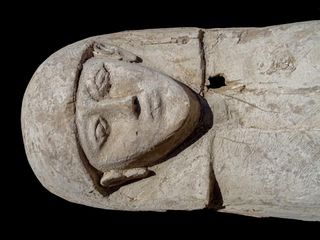By

Archaeologists found the coffin of a teenage girl from Egypt's 17th dynasty.
(Image: © Egyptian Ministry of Tourism and Antiquities)
Archaeologists in Egypt have discovered the ancient mummy of a teenage girl decked out in beautiful jewelry, including beaded necklaces and copper earrings, according to the Egyptian Ministry of Tourism and Antiquities.
Advertisement
The teenager was only 15 or 16 years old when she died during the 17th dynasty (1580 B.C. to 1550 B.C.). A team of Spanish and Egyptian archaeologists uncovered her mummified remains, as well as a pair of leather shoes, while excavating ahead of a construction project in an open courtyard by the tomb of General Djehuty, who served under king Thutmose III (stepson and nephew to the female pharaoh Hatshepsut) during the 18th dynasty, José Galán, director of the archaeological mission, said in a statement posted on Facebook.
The girl's mummy was resting on its right side in the Draa Abul Naga necropolis on Luxor's West Bank, according to Ahram Online, an Egyptian newspaper. Though the mummy had deteriorated over the millenia, restoration returned her jewelry to pristine condition. This included two spiral earrings coated with a thin metal leaf — possibly of copper — in one of her ears, as well as two rings on her fingers and four necklaces draped around her neck.
One ring was fashioned out of bone, while the other was made of metal and held an embedded blue glass bead with string wrapped around it. The four necklaces were tied together with a glazed ceramic, or "faience" clip.
Like the rings, each necklace was unique. One 27.5-inch-long (70 centimeters) necklace was made of round beads that alternated between dark and light blue faience, and another necklace, measuring 24.4 inches long (62 cm) necklace, had green faience and glass beads.
The third necklace was a treasure even by today's standards; the 24-inch-long (61 cm) necklace had 74 pieces, including beads of amethyst; a brownish-red gemstone called carnelian; amber; blue glass; and quartz, according to the Egyptian Ministry of Tourism and Antiquities. It also sported two scarabs, including one showing Horus (a god depicted as a falcon) and five faience amulets.
Finally, the fourth necklace was designed with several strings of faience beads, which were knotted together at both ends with a ring.
The 5.7-foot-long (1.75 meters) coffin was carved out of a sycamore tree trunk. At the time of the teenager's death, it had been whitewashed and painted in red, according to Ahram Online.
The archaeologists also found a miniature mud-made coffin that was still tied together with a string, near the teenager's mummy. When they opened this small coffin, the archaeologists found a wooden funerary figurine, known as an ushabti, wrapped in four linen bandages. The figurine and one of the bandages were marked in hieratic (an ancient Egyptian cursive text) with the name of the owner: "The Osiris, Djehuty."
Advertisement
The excavation team also found a pair of leather sandals and leather balls tied together with a string, which also dated to the 17th dynasty
"The sandals are in a good state of preservation, despite being 3,600 years old," Galán said. These shoes were dyed red and engraved with images of the god Bes, the goddess Taweret, a pair of cats, an ibex and a rosette, according to Ahram Online.
Based on the sandals' size and decorations, it's likely that they belonged to a woman, Galán said. The balls were used by women for sport or for choreographed dancing, according to images of daily life found in the Beni Hassan tombs from the Middle Kingdom (2040 B.C. to 1782 B.C.) of Egypt.


Δεν υπάρχουν σχόλια:
Δημοσίευση σχολίου